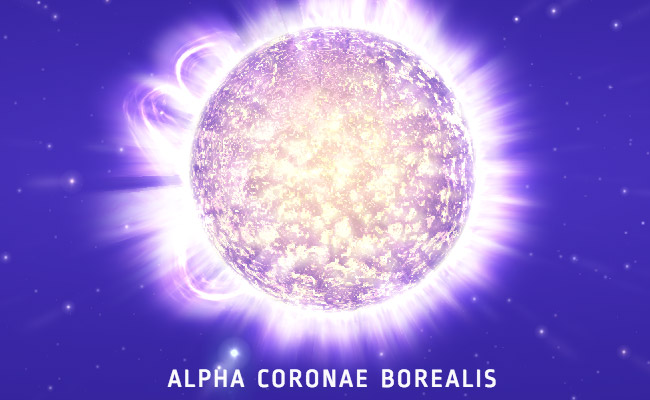Alpha Coronae Borealis – Star Facts

Alpha Coronae Borealis is the brightest star of the seven that make up the semicircle of the “Northern Crown.” This is a binary star system with its companion star completing an orbit every 17.4 days. There could also be a planetary system in its orbit. In the 2nd century, Greek astronomer, Ptolemy, catalogued this star along with the 88 constellations.
Constellation Home
Alpha Coronae Borealis is located approximately 75 light-years away in the constellation of Corona Borealis where it makes up part of the semicircle of the “Northern Crown.” It is also believed to be a member of the Ursa Major Moving Group, which includes some of the brightest stars that share a common movement through space.
Observation
If you are in the mid-northern latitudes this star is best viewed between April, May and June where it will be visible to the unaided eye for most of the night. Moving into July, Alpha Coronae Borealis will move to evenings and hang out there until around mid-November when it will begin to appear lower in the west-northwest early evening sky. After nightfall it will then re-emerge before dawn in the east-northeast sky. To quickly find Alpha Coronae Borealis simply draw an imaginary line between the two most luminous stars of the summer night sky, Arcturus and Vega.

View Alpha Coronae Borealis in 3D!
Star Characteristics and Features
Alpha Coronae Borealis is an eclipsing binary star that orbits its companion every 17.4 days. The primary star is classified as a white class A0V main sequence which shows an excess of infrared radiation. Due to this it is believed to have a large dust-disc around it which could possible mean a planetary (or proto-planetary) system in its orbit. The secondary star is a young yellow main sequence that has 0.92 times the mass and 0.90 times the radius of the Sun. It also shows 30 times the x-ray luminosity of the Sun.
Brightness of the Star
Alpha Coronae Borealis is the brightest of the seven stars that makes up “the crown.” Because it is being eclipsed by its companion star, it has a variation in its visual magnitude between 2.21 and 2.32.
History and Mythology
In the 2nd century Greek astronomer, Ptolemy, catalogued this star along with 88 constellations we know today. In Greek mythology, the c-shaped “crown” of the constellation Corona Borealis was said to represent the crown worn by a princess named Ariadne (daughter of Minos of Crete) on her wedding day. She married the Greek god of wine and fertility, Dionysus, who later placed her crown in the night sky to commemorate their wedding day.
Alpha Coronae Borealis is not just another twinkling celestial object, it has some cold hard facts and true significance. So if you have a chance to view this natural wonder in the Corona Borealis constellation be sure to take a look at one of the most intriguing views you may ever experience.
